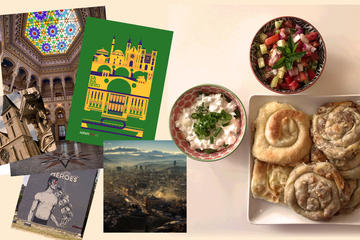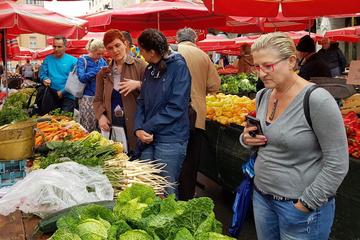When most people think of Croatia, they picture the summer crowds, packed beaches, and lively waterfronts. But for those who prefer peace, comfort, and authenticity, October paints a very different picture.
During these days, the air turns crisp, the Adriatic glistens under softer sunlight, and the streets become quieter. Hence, it becomes a perfect spot for travelers seeking a more intimate experience.
For a fact, October sits at that sweet spot between summer’s rush and winter’s chill. It’s the month when you can explore the scenic Split Rock Saddle in Croatia freely and experience the country as locals do.
That said, here’s why October stands out as the best time to visit Croatia. There you go!
1. Fewer Crowds and Effortless Travel
By October, the summer crowds have drifted away, leaving behind tranquil towns and open landscapes. Places like Dubrovnik, Split, and Rovinj feel different now. Of course, they are still full of life, but in a gentler, more local rhythm. You can walk along ancient city walls without waiting in line or stop at roadside cafés where locals gather to sip coffee and watch the world go by.
Traveling in Croatia in autumn also means the roads are clearer, and the entire experience feels more effortless. It’s a great time to take scenic drives through wine valleys, mountain passes, and coastal stretches that glow in warm, golden light.
The best part? For those who want to experience this kind of easygoing travel, reliable transfer options make a big difference. Some trusted companies like Taxi4Travel make it easy to explore the place at your own pace. Whether it’s a scenic drive to a vineyard, a coastal village, or a mountain retreat, having a trusted local driver lets you simply sit back and enjoy the journey.
Ultimately, during this time of the year, Croatia truly belongs to the explorers — the ones who love quiet beauty and authentic encounters.
2. Perfect Weather for Exploring and Adventure
October in Croatia brings mild and pleasant weather. It is warm enough for outdoor adventures yet cool enough for comfortable sightseeing. The coastal areas typically see temperatures between 18 and 22°C. On the flip side, inland regions offer that crisp fall breeze perfect for hikes and nature walks.
This balanced climate allows travelers to experience the best of both worlds. You can enjoy a beach picnic one day and explore national parks or historic fortresses the next. It’s also an excellent month for sailing, cycling, and hiking without the intense summer heat. Moreover, the Adriatic waters remain relatively warm in early October. So, if you’re feeling brave, a quick dip is still possible.
3. Lower Prices and Flexible Travel Plans
Another major advantage of visiting Croatia in October is affordability. Hotels, guesthouses, and villas often reduce their rates after the high season ends. That makes luxury stays surprisingly budget-friendly. Airfares also drop, and you’ll find plenty of last-minute deals for both accommodation and tours.
Beyond savings, flexibility becomes your best friend. You can linger longer in a favorite destination, change routes spontaneously, or stop at charming roadside cafés without worrying about crowds or bookings. Even top attractions like Plitvice Lakes or Krka National Park are easier to access, with shorter lines and quieter trails.
Since October is considered the shoulder season, you’ll find it much easier to experience Croatia your way.
4. A Taste of Croatia’s Autumn Culture and Harvest
October marks the beginning of Croatia’s harvest season, when vineyards, olive groves, and farms come alive with activity. Local festivals celebrate everything from wine and truffles to chestnuts and olive oil, giving travelers a chance to taste authentic Croatian culture.
In Istria, for example, truffle season peaks in October, and the air fills with the rich aroma of this prized delicacy. Meanwhile, along the Dalmatian coast, small fishing towns host food fairs where you can sample seasonal dishes prepared with freshly caught seafood and local produce.
It’s also a time when cultural life flourishes. Zagreb hosts film festivals, local art exhibitions, and music events, while coastal towns blend summer’s lingering charm with autumn’s cozy pace. This blend of flavor, culture, and tradition makes traveling in October feel like stepping into Croatia’s true identity — vibrant, welcoming, and proudly local.
Conclusion
October isn’t just another travel month in Croatia — it’s a revelation. It’s when the beaches belong to the locals again, the sunsets glow warmer, and the entire country slows down to breathe. Travelers get the best of both worlds: the lingering beauty of summer and the charm of autumn.
From peaceful road trips and affordable stays to rich cultural celebrations, the place proves that travel magic doesn’t always happen in peak season. Sometimes, it’s waiting quietly — on the open roads, along the quiet harbors, and in the soft golden light of autumn.
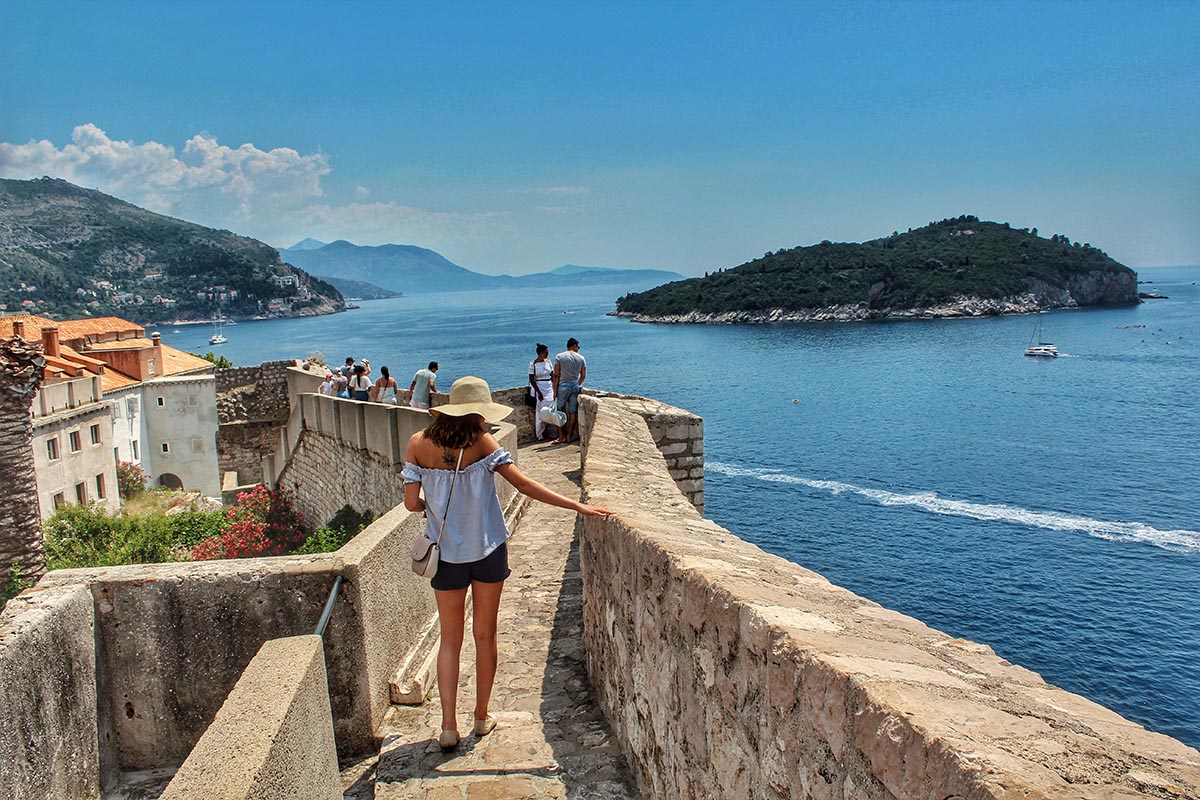


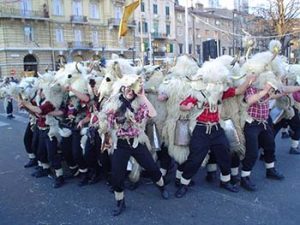

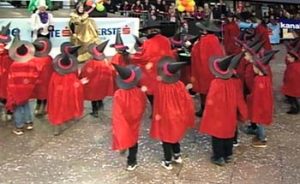

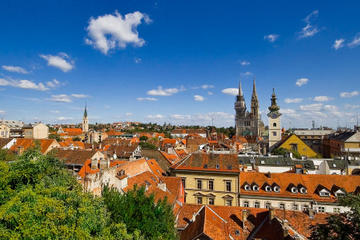
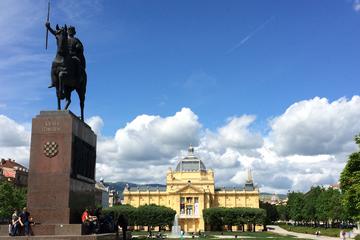

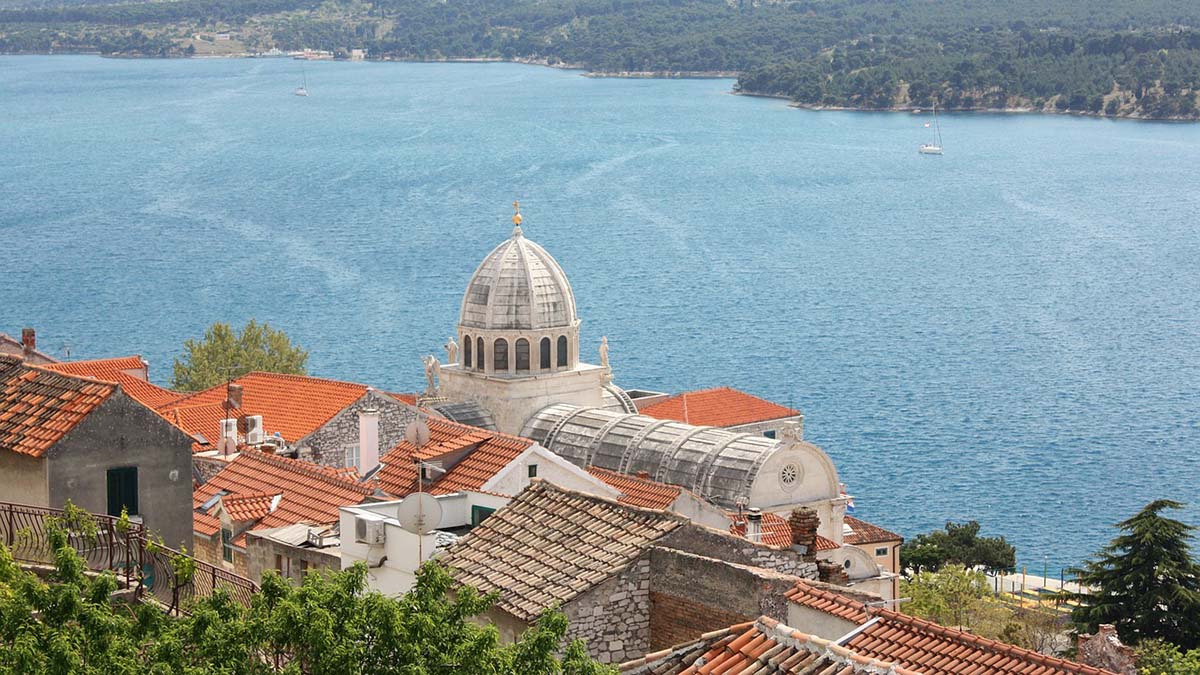
 LEADERSHIP STRIFE
LEADERSHIP STRIFE
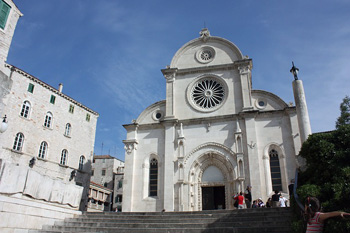 The cathedral of St James is by far the most impressive achievement in the city and it defies comparison due to its excellent construction. This three-nave Gothic Renaissance is the brainchild of Juraj Dalamanatic and was built during a period of Turkish attacks. What you see today actually took more than a century to build. Interestingly, there are 72 stone heads around the cathedral which represent locals who did not care to give a hand in the construction of the cathedral. I read a lot about this cathedral before visiting it and my friends told me that I should definitely go and check this building out when I visited Sibenik so of course I did. It is a massive building that towers over you but every piece of it contains a different kind of beauty that you just cannot stop looking at. I spent a couple of hours there just enjoying the view and learning a bit about this marvelous building, completely mesmerized.
The cathedral of St James is by far the most impressive achievement in the city and it defies comparison due to its excellent construction. This three-nave Gothic Renaissance is the brainchild of Juraj Dalamanatic and was built during a period of Turkish attacks. What you see today actually took more than a century to build. Interestingly, there are 72 stone heads around the cathedral which represent locals who did not care to give a hand in the construction of the cathedral. I read a lot about this cathedral before visiting it and my friends told me that I should definitely go and check this building out when I visited Sibenik so of course I did. It is a massive building that towers over you but every piece of it contains a different kind of beauty that you just cannot stop looking at. I spent a couple of hours there just enjoying the view and learning a bit about this marvelous building, completely mesmerized.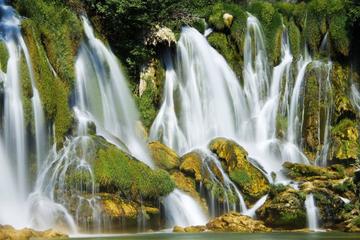

 The origins of the city can be traced all the way to the Romans. The Roman Emperor Diocletian, who lived in the 4th century AD, wanted to build himself a retirement mansion. He liked the area of today’s Split for its natural beauties and the warm Adriatic Sea, so he had it built there. In the centuries that followed, the city of Split grew around it, even after the Romans were long gone. The Palace and its surroundings eventually become the historical city core of Split (or Split Old Town), and nowadays the remains of the Diocletian’s Palace are among the best preserved remains of a Roman palace in the world. It was included in the register of the UNESCO World Cultural Heritage in 1979, and is even featured on Croatian banknotes. Built in an irregular rectangle, it was a combination of a luxurious villa and a military camp. Its walls and the center court, the Peristyle, now housing various vendors and souvenir shops, can be explored freely by tourists. However, a tour through its cellar includes a 5 Euro entrance fee.
The origins of the city can be traced all the way to the Romans. The Roman Emperor Diocletian, who lived in the 4th century AD, wanted to build himself a retirement mansion. He liked the area of today’s Split for its natural beauties and the warm Adriatic Sea, so he had it built there. In the centuries that followed, the city of Split grew around it, even after the Romans were long gone. The Palace and its surroundings eventually become the historical city core of Split (or Split Old Town), and nowadays the remains of the Diocletian’s Palace are among the best preserved remains of a Roman palace in the world. It was included in the register of the UNESCO World Cultural Heritage in 1979, and is even featured on Croatian banknotes. Built in an irregular rectangle, it was a combination of a luxurious villa and a military camp. Its walls and the center court, the Peristyle, now housing various vendors and souvenir shops, can be explored freely by tourists. However, a tour through its cellar includes a 5 Euro entrance fee.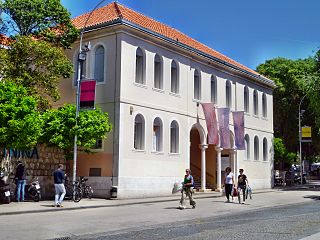 A city of such interesting history has several museums and galleries in which parts of that history are exhibited. For instance, the Gallery of Fine Arts contains works spanning through six centuries, thus providing an overview of artistic movements in Split and Croatia. Founded in 1931, it houses one of the greatest exhibitions of paintings and sculpture by major Croatian artists, but dedicating space to contemporary art as well.
A city of such interesting history has several museums and galleries in which parts of that history are exhibited. For instance, the Gallery of Fine Arts contains works spanning through six centuries, thus providing an overview of artistic movements in Split and Croatia. Founded in 1931, it houses one of the greatest exhibitions of paintings and sculpture by major Croatian artists, but dedicating space to contemporary art as well.
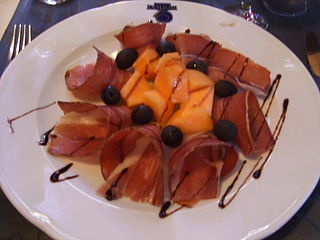 The cuisine of Split and the surrounding area is heavily based on seafood; fish, clams, oysters are usually boiled or grilled and served with vegetables or potato. Local delicacies include grilled sardines, the octopus salad, or the special kind of dry ham called “prsut”. Served with local wine, the food is usually not spicy, but some restaurants, drawing influences from other Mediterranean countries, started adding exotic spices to traditional Dalmatian dishes, giving them a new spin. For classic local delicacies search for a “konoba” sign, denoting a family-owned tavern specialized in authentic dishes. Of course, if you’re not a lover of seafood, there are plenty of fast food joints in every part of the city.
The cuisine of Split and the surrounding area is heavily based on seafood; fish, clams, oysters are usually boiled or grilled and served with vegetables or potato. Local delicacies include grilled sardines, the octopus salad, or the special kind of dry ham called “prsut”. Served with local wine, the food is usually not spicy, but some restaurants, drawing influences from other Mediterranean countries, started adding exotic spices to traditional Dalmatian dishes, giving them a new spin. For classic local delicacies search for a “konoba” sign, denoting a family-owned tavern specialized in authentic dishes. Of course, if you’re not a lover of seafood, there are plenty of fast food joints in every part of the city. During the summer tourist season the local nightlife flourishes, especially along the Bacvice beachside, featuring several late-opening clubs and beach bars. But the city is big and diverse enough for anyone, with different clubs playing vastly different music. Electronic music lovers should proceed to the minimally decorated Quasimodo, Split’s top venue for DJ nights, or the Jungla (Hula Hula), playing house and techno music. Rock lovers should visit the Kocka or Judino Drvo, where local bands often perform. O’ Hara Music Club is popular among tourists, due to its attractive location at the Zenta waterfront; hosting great parties, it’s great for dancing and drinking. Also, a plethora of bars can be found at the main city promenade, locally known as Riva, which is a great place for slow walks among the rows of palm trees with the incredible view of turquoise Adriatic Sea.
During the summer tourist season the local nightlife flourishes, especially along the Bacvice beachside, featuring several late-opening clubs and beach bars. But the city is big and diverse enough for anyone, with different clubs playing vastly different music. Electronic music lovers should proceed to the minimally decorated Quasimodo, Split’s top venue for DJ nights, or the Jungla (Hula Hula), playing house and techno music. Rock lovers should visit the Kocka or Judino Drvo, where local bands often perform. O’ Hara Music Club is popular among tourists, due to its attractive location at the Zenta waterfront; hosting great parties, it’s great for dancing and drinking. Also, a plethora of bars can be found at the main city promenade, locally known as Riva, which is a great place for slow walks among the rows of palm trees with the incredible view of turquoise Adriatic Sea.
 The Palace is also the location of the annual Festival of Flowers (usually held in May), where exhibitors display their flower arrangements based on a particular theme. Visually stunning, it’s a must-visit if you’re in the city at that time. If you’re interested in Roman culture, you’ll be happy to hear that there’s a whole festival dedicated to it. The Days of Diocletian are usually held in late August, and the entire area of the Palace becomes a living monument to the Romans, featuring their cuisine, lifestyle, clothing and customs. Entertaining and educational at the same time, the Days of Diocletian are especially popular with kids.
The Palace is also the location of the annual Festival of Flowers (usually held in May), where exhibitors display their flower arrangements based on a particular theme. Visually stunning, it’s a must-visit if you’re in the city at that time. If you’re interested in Roman culture, you’ll be happy to hear that there’s a whole festival dedicated to it. The Days of Diocletian are usually held in late August, and the entire area of the Palace becomes a living monument to the Romans, featuring their cuisine, lifestyle, clothing and customs. Entertaining and educational at the same time, the Days of Diocletian are especially popular with kids.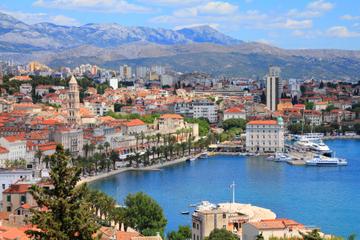

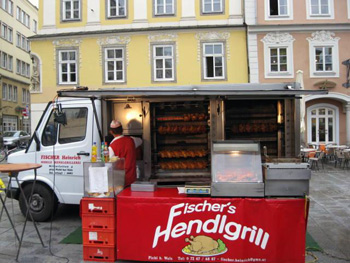
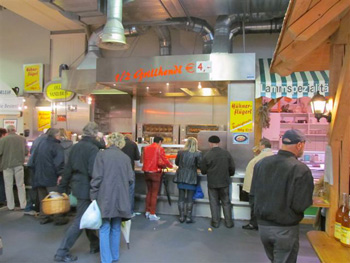 Some of my personal favorite ethnic eats are in Austria. In Wels a small town in the Northwestern section of the country there is a local market which is very similar to the Westside Market in Cleveland, Ohio. A new building was recently constructed to house the vendors. On the outside of the market vendors sell various fresh fruits and vegetables etc. Nothing there is prepackaged. Inside the building the vendors provide various types of fresh food including meat, poultry, eggs, cheese and even schnapps (whiskey). My favorite vendor has barbecue roast chicken on a spit and as of late a new item lightly breaded chicken wings which go well with a stein (a traditional German beer tankard) of beer. Priced by the kilogram (2.2 pounds) US $3.00-$5.00.
Some of my personal favorite ethnic eats are in Austria. In Wels a small town in the Northwestern section of the country there is a local market which is very similar to the Westside Market in Cleveland, Ohio. A new building was recently constructed to house the vendors. On the outside of the market vendors sell various fresh fruits and vegetables etc. Nothing there is prepackaged. Inside the building the vendors provide various types of fresh food including meat, poultry, eggs, cheese and even schnapps (whiskey). My favorite vendor has barbecue roast chicken on a spit and as of late a new item lightly breaded chicken wings which go well with a stein (a traditional German beer tankard) of beer. Priced by the kilogram (2.2 pounds) US $3.00-$5.00.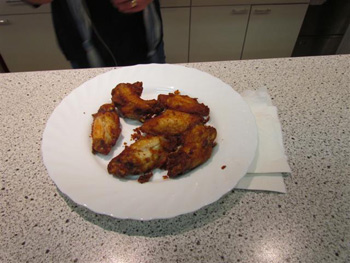 There are other taste treats to learn about and experience. Crossing from Slovenia into Croatia passing through village after village the signs for roast pork (svinjina) and lamb (jagnjetina grilled lamb both roasted on spit) began to appear. The local Gostionas (Restaurants, Bars) were preparing their grills for roasting. As luck would have it, we always seemed to miss many of these establishments. It might have been sheer luck and or just bad timing. We were either too early or too late for lunch or there was not a Gostiona located in the area where we were.
There are other taste treats to learn about and experience. Crossing from Slovenia into Croatia passing through village after village the signs for roast pork (svinjina) and lamb (jagnjetina grilled lamb both roasted on spit) began to appear. The local Gostionas (Restaurants, Bars) were preparing their grills for roasting. As luck would have it, we always seemed to miss many of these establishments. It might have been sheer luck and or just bad timing. We were either too early or too late for lunch or there was not a Gostiona located in the area where we were.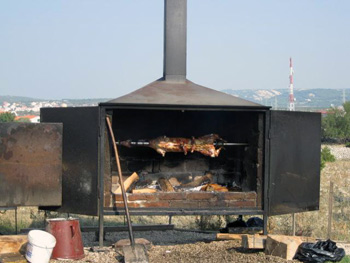 Having been in the former Yugoslavia a few times we learned over the years on what to look for when it comes to roast pork and lamb. Normally vendors and restaurateurs post signs advertising their wares along the road. Driving through Split on the Jadranska Magistrala along the coast toward Dubrovnik about lunch time we just could not find an establishment that had roast lamb or pork. Either we missed the signs or there just weren’t any. Finally we stopped at a local restaurant and we were given directions on where to find janjetina. Down the road and up the side of a sparsely covered mountain, we traveled higher and higher on the narrow pebbled road turning this way and that as the road curved back and forth along the side of the mountain, my cousin sitting in the back seat hanging firmly on to the hand strap fixed to the car roof. We drove on and on for over an hour. Finally we found it. The war had taken its toll. It was a bombed out building and on the side of the building a faded wooden sign advertised jagnjetina. My cousin started laughing hysterically!!! Someone was having a good laugh on us. Consequently we did not have roast pork or jagnjetina this day.
Having been in the former Yugoslavia a few times we learned over the years on what to look for when it comes to roast pork and lamb. Normally vendors and restaurateurs post signs advertising their wares along the road. Driving through Split on the Jadranska Magistrala along the coast toward Dubrovnik about lunch time we just could not find an establishment that had roast lamb or pork. Either we missed the signs or there just weren’t any. Finally we stopped at a local restaurant and we were given directions on where to find janjetina. Down the road and up the side of a sparsely covered mountain, we traveled higher and higher on the narrow pebbled road turning this way and that as the road curved back and forth along the side of the mountain, my cousin sitting in the back seat hanging firmly on to the hand strap fixed to the car roof. We drove on and on for over an hour. Finally we found it. The war had taken its toll. It was a bombed out building and on the side of the building a faded wooden sign advertised jagnjetina. My cousin started laughing hysterically!!! Someone was having a good laugh on us. Consequently we did not have roast pork or jagnjetina this day.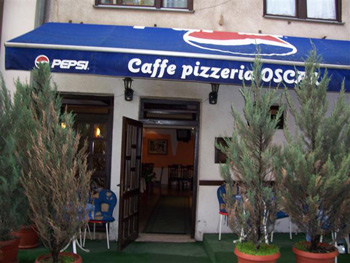 On another occasion we were traveling by bus from Sarajevo to Mostar we stopped in the town of Jablanica to view the local historical sights. We learned from the locals just on the outskirts about one kilometer south of Jablanica was the restaurant Zdrava Voda (Health Water). There on six roasting spits was lamb grilling on an open fire continuously throughout the day enough to quell the hunger for both the tourist traveling between Sarajevo and Mostar and the local population. The price was US $15.00 which included potatoes, salad, and bread. Jablanica is known for this mouth watering delicacy and that there are over 8 restaurants in the vicinity that serve it. www.zdravavoda.co.ba
On another occasion we were traveling by bus from Sarajevo to Mostar we stopped in the town of Jablanica to view the local historical sights. We learned from the locals just on the outskirts about one kilometer south of Jablanica was the restaurant Zdrava Voda (Health Water). There on six roasting spits was lamb grilling on an open fire continuously throughout the day enough to quell the hunger for both the tourist traveling between Sarajevo and Mostar and the local population. The price was US $15.00 which included potatoes, salad, and bread. Jablanica is known for this mouth watering delicacy and that there are over 8 restaurants in the vicinity that serve it. www.zdravavoda.co.ba
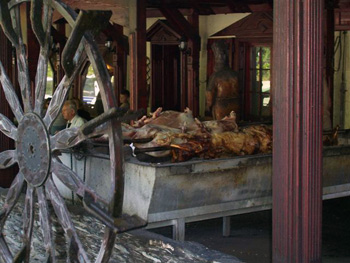 In Sarajevo the restaurant Cevabdzinica Zeljo, on street Kundurdziluk 18, in the Bascarsija seems to be the favorite place for locals to enjoy a “healthy” meal of cevapcici with onions, sour cream and yogurt. Cevapcici is beef minced meat in a roll served with pita bread and priced under US $7.00. Other versions of this delicacy are made with ground lamb, veal, and pork.
In Sarajevo the restaurant Cevabdzinica Zeljo, on street Kundurdziluk 18, in the Bascarsija seems to be the favorite place for locals to enjoy a “healthy” meal of cevapcici with onions, sour cream and yogurt. Cevapcici is beef minced meat in a roll served with pita bread and priced under US $7.00. Other versions of this delicacy are made with ground lamb, veal, and pork.